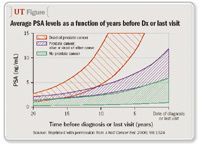Article
PSA velocity predicts prostate cancer survival earlier
Author(s):
Baltimore-PSA velocity measured 10 to 15 years prior to prostate cancer diagnosis is a significant predictor of cancer-specific survival 2 to 3 decades later, according to the results of a study published in the Journal of the National Cancer Institute (2006; 98:1521-7).

The project represents collaboration between researchers in the department of urology, Johns Hopkins University School of Medicine, and investigators at the National Institutes of Health's National Institute on Aging. Using PSA values determined from frozen serum samples collected from participants in the NIH-sponsored Baltimore Longitudinal Study of Aging launched in 1958, the investigators determined PSA velocity in 20 men who had died of prostate cancer, 140 men with prostate cancer who were alive or who had died of another cause, and 856 men with no diagnosis of prostate cancer.
The average patient was almost 50 years old at the time of the initial PSA test and had an average of five repeat PSA tests over a mean of 11 years. Index PSA values ranged from 0.1 to 20.0 ng/mL, with median values of 0.8 ng/mL for the entire group and 1.9 ng/mL among the men who had died of prostate cancer.

"Our study shows that PSA velocity measured at a time when PSA levels are low is one method to identify men with life-threatening disease who could benefit from being followed more carefully or undergoing an early prostate biopsy, even when PSA levels are below 4.0 ng/mL," he told Urology Times.
"As a corollary, the rate of change in PSA may also be a helpful tool for guiding management of men who have already been diagnosed with prostate cancer. In that population, PSA velocity may be used to identify individuals who potentially do not have life-threatening disease and who might be safely and appropriately followed with active surveillance."
Dr. Carter said he expects that the findings from this study will be confirmed. Such replication would lend further justification to the concept of initiating PSA screening earlier than at 50 years of age.
"In the year 2000, our group recommended that PSA screening be performed initially when men reach 40 years of age, with follow-up tests done at ages 45 and 50. The aim is not to increase cancer detection in younger men, but to establish a PSA history and baseline by the time a man reaches age 50, which can be used as a reference for comparing future data," he explained.

















